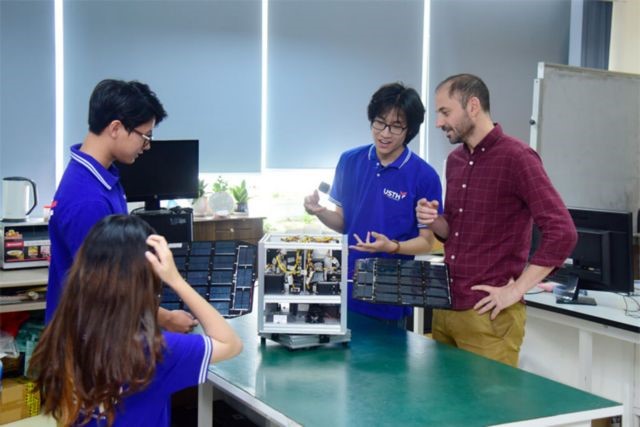Hà Nội has potential for becoming a semiconductor hub of the region and the world, given its location, connectivity, human resource market, incentives and especially the Capital Law.

As the fourth industrial revolution intensifies, Việt Nam is positioning itself to become a key player in the semiconductor industry. Experts emphasise the importance of crucial preparations to build an ecosystem that supports this sector.
"Human resources are Việt Nam's most valuable asset in this endeavour," said Nguyễn Thanh Yên, general director of Korea-invested CoAsia Semi in Việt Nam, at a conference on Wednesday.
The event, organised by the Hanoi Promotion Agency under the guidance of the Hà Nội People’s Committee, was part of the three-day Hà Nội Semiconductor Investment Festival 2024. The festival focused on how the capital city can exploit its potential and affirm its position on the global technology map.
The semiconductor industry is highly globalised and Việt Nam has significant opportunities to join the value chain, especially as geopolitical risks, including China's involvement in the supply chain, create shifts, according to Yên. Early preparation in human resources is critical to capitalise on these opportunities.
He cited a global talent shortage of around 505,000 semiconductor manufacturing jobs as a major challenge, stressing that Việt Nam must act promptly. "The opportunity is there. We must start now. Building human resources takes time, possibly 5–10 years," he said.
Chử Đức Trình, Principal of the University of Engineering and Technology under Việt Nam National University, Hà Nội, noted that no country could fully master the semiconductor industry from start to finish.
He suggested that Việt Nam should focus on specific stages to become an integral part of the global semiconductor ecosystem. Reflecting on the electronics industry's development a decade ago, where only foreign-invested companies benefited significantly from exports, Trình urged caution in policy formulation for the semiconductor sector.
"Việt Nam needs to attract foreign direct investment (FDI) to develop the semiconductor industry, but the key is how FDI can also benefit domestic firms," he said.
Trình pointed out Việt Nam's advantages, including a favourable geographical location, political stability, a strong foundation in electronics, and a young, skilled, and creative labour force.
The country also boasts over 70 technology and STEM universities, some with impressive global rankings.
Moreover, Việt Nam has received support from various countries and major technology corporations, as evidenced by recent visits from top leaders. However, the country still faces challenges such as limited technological mastery and insufficient integration into the global supply chain, according to Trình. Additionally, capital constraints are a significant hurdle. Only two localities, Hà Nội and HCM City, are currently capable of developing semiconductor ecosystems due to their abundant human resources.

"Hà Nội has the potential to become a semiconductor hub for the region and the world, given its strategic location, connectivity, skilled workforce, and favourable incentives. The Capital Law even prioritises semiconductors as a key industry to draw in strategic investors," Trình added.
To develop this sector, Hà Nội should create a supportive environment, coupled with an industrial ecosystem that attracts FDI and fosters startups. Investments in education and training would also be crucial to build a talented workforce.
"The city needs to collaborate with local universities to develop talent for the semiconductor industry," Trình emphasised, noting that human resource development must align with short-term, medium-term, and long-term goals.
"Hà Nội needs to position itself in the global semiconductor ecosystem and prepare a workforce capable of seizing opportunities," he said. "Realisation starts with a dream. I believe that with good preparation, Hà Nội can achieve significant success in the semiconductor industry."
Nguyễn Nhật Quang, Director of the Việt Nam Science and Technology Institute under the Việt Nam Software and IT Services Association, underscored that human resources are the most significant opportunity for Việt Nam's participation in the semiconductor industry.
He stressed that talent development should aim at building a labour force for the global market, not just for Hà Nội or Việt Nam. He noted that while it might take other countries 20-30 years to develop a semiconductor industry, Việt Nam could potentially shorten this timeframe to 15-20 years by leveraging its latecomer advantages. However, the global semiconductor value chain could shift within 3-5 years, requiring immediate action.

Quang emphasised the need to build a semiconductor ecosystem alongside digital and green industries, which are core to the fourth industrial revolution. He highlighted Hà Nội's commitment to becoming a smart city, as reflected in its urban planning.
To achieve this goal, the city would need a robust and secure digital information infrastructure, which would require a substantial number of semiconductor chips. Developing local expertise in electronic technology and semiconductors would be crucial for safely and sustainably building and operating a smart city.
He also stressed that the development of Hà Nội's semiconductor industry must align with the master plan for the entire capital region and the country. Notably, a semiconductor industrial belt was forming in the capital region, including Bắc Ninh, Thái Nguyên, and Bắc Giang provinces.
The Hà Nội Semiconductor Investment Festival 2024 concluded on Wednesday, providing a platform for policymakers, industry insiders, and enterprises to discuss solutions to promote investments and enhance cooperation in Việt Nam's semiconductor industry. — VNS





